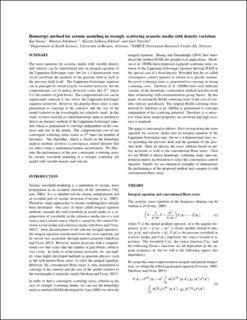Homotopy method for seismic modeling in strongly scattering acoustic media with density variation
Journal article, Peer reviewed
Accepted version
Permanent lenke
https://hdl.handle.net/11250/2764076Utgivelsesdato
2020Metadata
Vis full innførselSamlinger
- Department of Earth Science [1050]
- Registrations from Cristin [9791]
Originalversjon
SEG technical program expanded abstracts. 2020, 2689-2693. 10.1190/segam2020-3426347.1Sammendrag
The wave equation for acoustic media with variable density and velocity can be transformed into an integral equation of the Lippmann-Schwinger type; but for a 4-dimensional state vector involving the gradient of the pressure field as well as the pressure field itself. The Lippmann-Schwinger equation can in principle be solved exactly via matrix inversion, but the computational cost of matrix inversion scales like N^3, where N is the number of grid blocks. The computational cost can be significantly reduced if one solves the Lippmann-Schwinger equation iteratively. However, the popular Born series is only guaranteed to converge if the contrasts and the size of the model (relative to the wavelength) are relatively small. In this study, we have used the so-called homotopy analysis method to derive an iterative method of the Lippmann-Schwinger equation which is guaranteed to converge independent of the contrasts and size of the model. The computational cost of our convergent scattering series scales as N^2 times the number of iterations. Our algorithm, which is based on the homotopy analysis method, involves a convergence control operator that we select using a randomized matrix factorization. We illustrate the performance of the new convergent scattering series by seismic wave-field modelling in a strongly scattering salt model with variable density and velocity.
